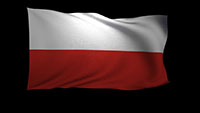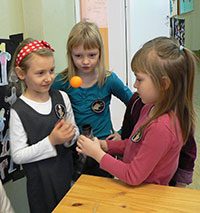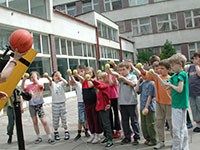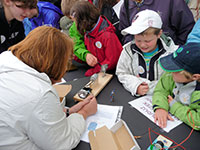Making physics flourish in Poland: Maria Dobkowska Inspire article
Physics teacher Maria Dobkowska describes the challenges of remaining creative within a strictly defined national curriculum and of working with children with disabilities.

for free.com
When the first two eminent speakers at a national conference for physics teachers in Poland pause in their opening comments to thank you for inspiring them to study physics, you must be doing something right.

Image courtesy of Boguslawa
Rotter
There can be no doubt that the recipient of that recognition, Maria Dobkowska, followed the right career path: her happy 39 years of teaching experience in Poland prove it. “I’ve always been a social person. I liked working with people,” she explains, “and I knew that working in a scientific laboratory wouldn’t interest me. After my time as a trainee teacher, I knew for sure that it was the job for me.”
Maria’s enthusiasm has served her well, particularly when facing the considerable challenges posed by the Polish school system (see box on the Polish education system).
“In Poland we have strictly defined national curricula for each separate subject. You can only introduce your own topics in extra-curricular activities – outside of lessons,” Maria explains.
Unfortunately, according to Maria, successive education reforms in Poland have reduced the number of lessons in physics, but not the extent of the material that needs to be covered before the national exams. “Even during extra-curricular activities, teachers are more focused on preparing students for the examinations than on expanding or introducing new content.” Furthermore, the lack of funds for extra-curricular activities means that the needs of gifted and talented students are not always met.

the student competition,
‘Taking photos of physical
phenomena’, the student
demonstrated how water
expands as it freezes
Click on image to enlarge
Images courtesy of Julia
Wojciechowska (aged 15)
Many teachers would struggle in such a constrained system but Maria has risen to the challenge. In doing so, she has created resources that have helped other teachers both nationally and internationally.
“I started a student competition, ‘Taking photos of physical phenomena’, initially in my school. It was a great success: some of the photos were so good that they were used as illustrations in the physics handbooks for lower secondary school. Many cities in Poland are now successful conducting similar competitions– this makes me very proud.”
About 10 years ago, together with Miroslaw Los, who teaches physics and information and communications technology (ICT), Maria began making videos of interesting physics experimentsw1. This was in response to the needs of lower secondary-school physics teachers who wanted to make their lessons more engaging but lacked the time and / or equipment. Over time, Maria and Miroslaw extended this resource to include animations and interactive simulations. Today, all the materials are included in Polish physics textbooks and are available on CD, as well as via the website of Wydawnictwa Szkolne i Pedagogiczne, one of the oldest and largest educational publishing houses in Poland. Maria has also co-authored many print publications to support the teaching and learning of physics.

A: When the weight of the bottle is less than the upward force of buoyancy, the bottle floats.
B: When the weight of the bottle is equal to the upward force of buoyancy, the bottle is suspended in the water column.
C: When the weight of the bottle is greater than the upward force of buoyancy, the bottle sinks
Images courtesy of Piotr Dobranowski (aged 15)
Furthermore, through her involvement in Science on Stagew2, a network of local, national and international events for teachers, Maria has shared her ideas with teachers from many other European countries. Not only has she presented projects at three Science on Stage international teaching festivals, but she has helped to organise Science on Stage Poland since 2006. Together with other teachers involved in Science on Stage, she has contributed to the international publications Teaching Science in Europe: What European Teachers Can Learn From Each Otherw3.
After many years of teaching, followed by a long career break to raise her family, Maria was ready for a new challenge. In 1994, she started teaching physics at a newly established integrated school, an open-plan school where able-bodied and physically disabled students (aged 6-19) learn together. In each class, there are about five students with disabilities and no more than 20 students in total. In addition to the subject teacher, there is a special educator in the classroom, and students with severe disabilities have a personal assistant, for example to help with writing. There are also specialists to help students overcome difficulties in speaking, reading and memorising, and to provide medical assistance. Such schools are rare in Poland.

Venus
Image courtesy of Boguslawa
Rotter
“The way of working with these students was something entirely new for me and it was a real challenge. I had to change my working methods. Thanks to this school, I became more creative, innovative and courageous in my selection of experiments and demonstrations. I started to give my students more freedom to find their own solutions and I also started to work with projects – an almost unknown method in Poland.” This creativity led to Maria’s involvement in three international, EU-funded school projects, such as ‘Handicapped children in Europe get to know each other’, which integrated science with art, food and cultural heritage.
Of course, even the best teacher’s lessons don’t always go to plan. “Last year, I had been preparing a scientific experiment to show that fresh eggs sink in water, but that as they get older, their density changes until they float. I don’t remember how long I kept these eggs in my lab before I decided to use one of them in another lesson to show that eggs are fragile. I wanted to show it spectacularly and I dropped an egg onto a tray on the floor. The stinking gas from the egg quickly spread throughout the whole school! The students were very amused by what had happened during their lesson. Other students still ask when I am going to make such an egg again!”

school at the national
‘science picnic’
Image courtesy of Natalia Witt
It could be argued that the success of a teacher can be proven by the success of their students. Maria recounts, “Michal is severely disabled with cerebral palsy: he is confined to a wheelchair and has difficulty with speech and co-ordination. I taught him physics at our gimnazjum and liceum and now he is finishing his third year of physics at Warsaw University!”
In an ideal world, Maria would like more science lessons per week and more freedom within the curriculum. More funds for equipment would mean more hands-on experiments.
Open science labs, maybe at universities, would encourage students interested in pursuing physics at a higher level. Above all, however, Maria is keen to continue her professional development: “Conferences and workshops are very helpful, and despite my many years of work as a teacher, I can still learn something new.” That’s an attitude worth passing on to any student.
The Polish education system
| Szkoła podstawowa (primary school) | Stage 1: age 7-10 All teaching is integrated, with no separate subjects Stage 2: age 10-13 Separate subjects are introduced. The only scientific subject at this stage is nature, which consists mainly of biology and geography, with a small amount of physics and chemistry. The students receive three hours per week of nature lessons. |
|---|---|
| Gimnazjum (lower secondary school) | Stage 3: age 13-16 Teaching is based on separate subjects – biology, chemistry, geography and physics. For each of these subjects, the students receive 130 hours over the three-year period. For example, they may receive one hour per week in the first year, two in the second year and one in the third year. |
| Liceum ogólnokształcące (upper secondary school) | Stage 4: age 16-19 As of 2012, science is taught as separate subjects only in the first year of Stage 4. Per subject, the students receive one hour of lessons per week. For the second and third years of Stage 4, students choose to focus on either science or humanities. Over those two years, students who focus on science receive four hours of lessons per week for each science subject (biology, chemistry, geography and physics). Students focusing on humanities receive one hour per week of integrated science (nature) lessons. |
Web References
- w1 – One of the activities that Maria and Miroslaw devised together involves using infrared cameras, for example to visualise the transfer of energy from a bouncing ball to the surface it bounces on.
- For an English description of the project, see pages 66-67 of the Science on Stage publication Science Teaching: Winning Hearts and Minds.
- The website of Wydawnictwa Szkolne i Pedagogiczne has a Polish explanation of the project (‘Kamera na podczerwień w nauczaniu przedmiotów przyrodniczych’).
- The Naked Scientists website offers instructions for making your own infrared camera.
- w2 – Science on Stage is a network of local, national and international events for teachers, initially launched in 1999 by EIROforum, the publisher of Science in School. At each national Science on Stage event, a delegation of teachers is selected to represent their country at the Science on Stage international teaching festival.
- The next international festival will be held on 25-28 April 2013, in Słubice-Frankfurt (Oder) on the Polish-German border. During the festival, 350 teachers from 27 countries will share their most innovative teaching ideas in workshops, on-stage performances and the teaching fair. Participation is free for delegates. For other science teachers, there will be a limited number of places for which a registration fee will be charged. See the Science on Stage Europe website for details.
- w3 – As part of her involvement in Science on Stage, Maria contributed to the publications Teaching Science in Europe: What European Teachers Can Learn From Each Other.





